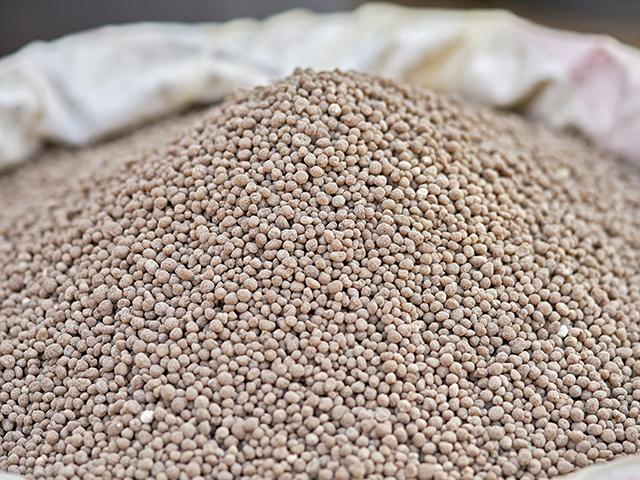Smart Sulfur Strategies
Smart Sulfur Strategies: Fall Application Saves Time Next Spring
ADVERTORIAL
Sulfur deficiency can steal valuable yield, especially since it's an essential nutrient for corn, canola, alfalfa and wheat -- responsible for plant function and growth during the season.
Researchers say and testing labs (soil and tissue tests) show sulfur (S) deficiency has become a widespread problem, compounded by fewer sulfur oxide emissions, more concentrated fertilizers with little to no S and high-yielding crops removing more sulfur.
The good news is that sulfur gives you options for fall, spring or in-season application when using the proper form. This flexibility becomes invaluable, especially when weather extremes create costly delays during spring fieldwork and planting, pushing farmers to increase fall fertility and tillage following harvest.
It's a myth that all sulfur applications are lost by leaching before spring. Dan Kaiser, University of Minnesota Extension nutrient management specialist, says it's true that the sulfate form of sulfur is mobile in the soil and subject to leaching, but not elemental sulfur.
P[L1] D[0x0] M[300x250] OOP[F] ADUNIT[] T[]
Fall application of elemental sulfur is safer because of less risk for leaching compared to a sulfate like AMS or gypsum.
Soil organisms must oxidize elemental sulfur to make it plant available. The rate of oxidation depends on soil temperature, soil moisture and elemental sulfur granule size.
"I am in the early years of a long-term study to determine how quickly elemental sulfur products will oxidize and provide sulfate sulfur to corn," Kaiser says. "I have been testing products with smaller elemental sulfur particle size, like Nutrien's Smart Nutrition™ MAP+MST®. I had some initial doubts about the benefits of elemental sulfur this far north in the Corn Belt, but given the right conditions, elemental sulfur can work, and we have seen corn yield with MAP+MST comparable to sulfate-sulfur sources. I highly suggest that growers know what form of sulfur is applied to their fields and keep an eye on fields where elemental sulfur is applied to watch for early season sulfur deficiencies."
Micronized Sulfur Technology (MST®) offers very fine particles that are evenly distributed within the granule of MAP, maximizing soil to fertilizer contact, says Dr. Cristie Preston, agronomist for Nutrien. "By broadcast and incorporating it, you maximize elemental sulfur oxidation. Once soils begin to warm up in the spring, microbial activity will increase, and the sulfur in Smart Nutrition MAP+MST converts to plant available sulfate."
Kaiser suggests farmers consider four things to optimize fall sulfur efficiency:
1. Your crop. Corn, alfalfa and canola have shown the greatest benefit with sulfur fertilization. Small grains have also shown potential response on low organic matter soils (3% or less).
2. Soil type. Fall application of sulfate is not ideal for medium to coarse texture. Fall application may work for fine textured soil.
3. Sulfur source. Sulfate sulfur presents the greatest risk for leaching in the fall. Elemental sulfur does not leach, but it's difficult to predict the oxidation of elemental sulfur to sulfate (ready for crop uptake) in the spring.
4. Past results. Since weather impacts sulfur availability, evaluate previous fall sulfur application results. If you are consistently dealing with sulfur deficiency in the spring following fall fertilizer application, a small amount of sulfur should be considered to get crops through early growth stages when soils are cool. Research shows you can correct sulfur deficiency in corn through the V5 growth stage without yield reduction.
SULFUR MYTHS:
Sulfur applications made in the fall are lost by leaching before spring.
Fact: It's true that sulfate leaching is a major concern for fall-applied sulfur. However, since the sulfur in Smart Nutrition MAP+MST is primarily elemental as MST®, the sulfur must be oxidized to sulfate before there is a chance of loss. Ideally, Smart Nutrition MAP+MST applications in the fall should occur after the soil temperatures drop below 50 degrees. Below this point, soil microbial activity decreases and reduces the rate at which elemental sulfur is converted to sulfate. Once soils begin to warm up in the spring, microbial activity will increase, and the sulfur in Smart Nutrition MAP+MST will be converted to plant available sulfate.
> ©2020 Nutrien Ltd.; SMART NUTRITION, NUTRIEN logos and designs are registered trademarks owned by Nutrien Ltd. MST® logos and designs are registered trademarks owned and used under license by Sulvaris Inc.
[PF_1020]
(c) Copyright 2020 DTN, LLC. All rights reserved.




